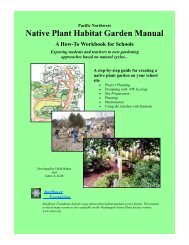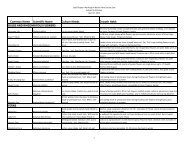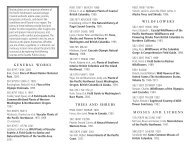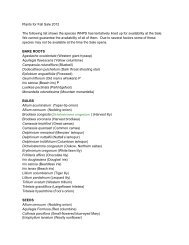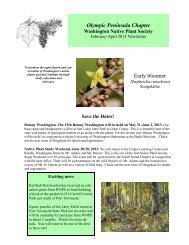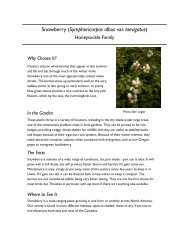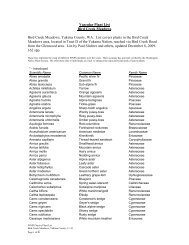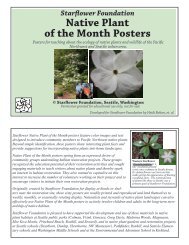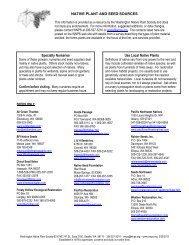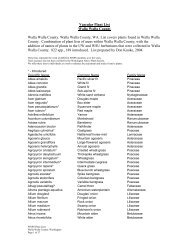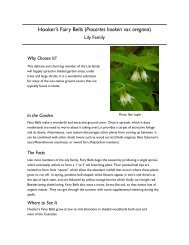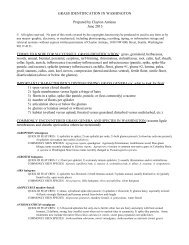Quick & Easy Habitat Education Activities - Washington Native Plant ...
Quick & Easy Habitat Education Activities - Washington Native Plant ...
Quick & Easy Habitat Education Activities - Washington Native Plant ...
Create successful ePaper yourself
Turn your PDF publications into a flip-book with our unique Google optimized e-Paper software.
<strong>Quick</strong> & <strong>Easy</strong> <strong>Habitat</strong> <strong>Education</strong> Activity DescriptionsThese ‘Activity Description’ pages may be copied, cut andassembled with associated activity cards to make working card setsKindergarten Theme: Discovering that animals need plants for food and shelterK-1 Everybody Needs a Home This introductory etiquette activity helps students gain awareness of, and empathy towards, wildlife that make theirhomes in habitat areas. Students listen to a story and offer feedback about how they might behave when visiting habitatareas. This activity is designed to be followed by Homes in the <strong>Habitat</strong> Walk activity, with a visit to a habitat areato look for wildlife homes.K-2 Homes in the <strong>Habitat</strong> Walk Students take a walk in a habitat area, and look for evidence of wildlife homes of all kinds, including those of insects,birds and mammals. Students demonstrate good outdoor etiquette including not disturbing these wildlife homes. Studentsdraw a picture of a wildlife home, and the animal they think may use it.K-3 Nature Detective Discovery Students become ‘Nature Detectives’ using their senses to discover and observe different natural objects from thehabitat area. They use touch, sight, smell and hearing to investigate sensory sets of ‘Mystery Nature Objects’ andaudio recordings of animal sounds. At the end of each set they learn the name of its plant or animal. This activity isdesigned to be followed with Nature Detective Walk.K-4 Nature Detective Walk Students go to a habitat area and use their senses to learn about the plants and animals they studied during the NatureDetective Discovery activity. They learn about ways to identify these plants and animals using their senses of touch,sight, smell and hearing. They may also use the sense of hearing to discover birds or other animals while going ontheir walk.K-5 Mystery Animal Students hear clues about an animal native to the Pacific Northwest which lives in Seattle urban habitat areas. Studentstry to guess the animal as clues are being read. After reading through all the clues the students are shown thecorrect picture of the animal and discuss what they have learned.K-6 Animals, Animals This interactive, role playing activity introduces students to many types of wildlife in Seattle urban habitat areas.Students work in teams to role play wildlife shapes, movements and sounds while other students make guesses.K-7 Bird Beak Buffet This activity introduces students to the concept that characteristics of animals and plants are related to their survival.Students learn that different birds have different types of beaks. They use models of these beaks to gather differenttypes of ‘foods’ and learn that gathering success is limited by the type of ‘beak’ they have.K-8 Bird Observation Walk Students go into the habitat area and use their binoculars and ears to look and listen for birds. They try to find threebirds by sight, and three birds by sound. Students discuss the behavior of the birds and their association with plants.<strong>Quick</strong> & <strong>Easy</strong> <strong>Habitat</strong> <strong>Education</strong> Activity DescriptionsFirst GradeTheme: Observing plant and animal characteristcs1-1 The Magic Glasses Story This activity teaches proper outdoor etiquette and precedes going into the habitat area. Students hear a story aboutchildren who ran and shouted all the way to a wildlife habitat area, excited to see wildlife but saw none. The childrenlearn about ‘Magic Glasses’ and good behavior. This is followed with a walk in a habitat area to observe wildlife.1-2 Magnifier Walk Students go on an unstructured exploratory walk in the habitat area while practicing their outdoor etiquette skills. Studentsuse magnifiers to freely observe natural objects they encounter on the walk. This allows students to practice usingmagnifiers, and to familiarize themselves with the many interesting things in their habitat, prior to other activities.1-3 Creepy Crawly Story This activity introduces students to the tiny wildlife that live in habitat areas; many of these animals may already befamiliar to them. Students listen to a guided imagery story and act out the behaviors of certain invertebrates that arelikely to be found in the habitat area. This activity is designed to be followed by Creepy Crawly Exploration.1-4 Creepy Crawly Exploration Students go to the habitat area where exploration stations are set up. Using plastic cups and spoons, students collect‘creepy crawly’ invertebrates they find in the soil duff. Students try to identify these tiny animals using an invertebrateidentification sheet and share their finds with other students. Students return the animals to the soil duff or use them inthe ‘Organisms’ science kit terrarium.1-5 Bark & Leaf Rubbings This activity serves to reinforce knowledge about the parts of a plant, and helps students recognize that different plantshave different characteristics. Students make leaf and bark rubbings from four different plant species in a habitat areaand then use these rubbings to sort by characteristics. The rubbings are also used to find the plants again, using thecharacteristics as ‘clues’.1-6 <strong>Plant</strong>s & Animals:Same/DifferentStudents consider the commonalties and differences between plants and animals in the habitat area. Their observationsare recorded using a classroom-size Venn diagram that distinguishes between characteristics that are different, andthose that are the same, between plants and animals.1-7 Maple Seed Mix-Up This interactive game helps students understand the combination of basic environmental conditions necessary fora seed to sprout. Students role-play a seed or one of its needs (sun, soil and water) in a game similar to cake walk.Where a ‘seed’, ‘water’, ‘sun’ and ‘soil’ have landed together on a ‘base’, a seed can sprout. Students then evaluateoutdoor areas that may or may not provide those same needs.1-8 <strong>Plant</strong> and AnimalInteraction HikeThis activity connects the previous activities by asking students to use their observation skills to explore the relationshipbetween animals and plants. Students learn to find wildlife sign, then to recognize how plants are being used bywildlife. Students use picture cards to help find and identify these wildlife and plant interactions.1-9 Drawing for Reflection Students draw a picture of an animal and plant interaction from their observations made during the <strong>Plant</strong> and AnimalInteraction Hike. While best done in the habitat area, drawing may be done in the classroom from memory. Thesedrawings can be used for assessment, classroom presentations and/or displays.



